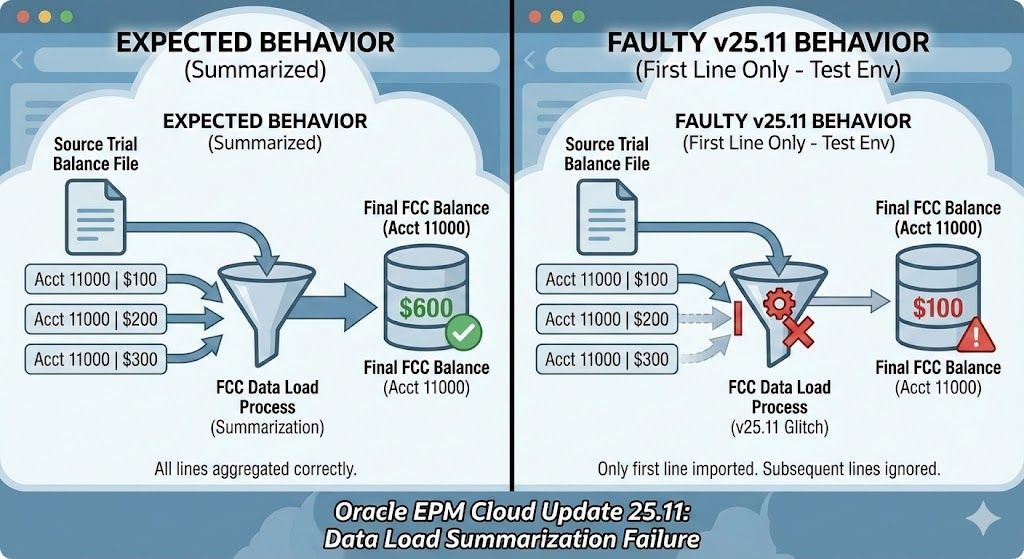4 Pillars of Master Data Governance with Oracle EDM
Nadia Lodroman | Oracle EPM Consultant | Integrity in Every Insight.
15 August 2025
Listen to Tresora and Ledgeron's chatting about this blog post:
Governance and Automation with Oracle EDM
When integrating multiple systems like JD Edwards into a single procurement platform like Coupa, managing the metadata mappings is more than an IT task—it's a critical governance function. A single incorrect mapping can lead to failed transactions, flawed financial reporting, and compliance breaches. Spreadsheets and manual processes don't offer the control you need.
This is where Oracle Enterprise Data Management (EDM)
establishes its authority. It’s not just a place to store mappings; it's an active governance engine that ensures every change is deliberate, audited, and seamlessly integrated into your enterprise applications. Let's explore the core features that make this possible.
1. Unbreakable Governance: The Full Audit Trail and Four-Eyes Principle
The cornerstone of any robust data management process is auditability. Oracle EDM is built on a foundation of complete transparency and control.
Every single change to a mapping—whether it's adding, updating, or deleting a relationship—is captured in a detailed, immutable audit trail. You can see precisely who requested a change, what the change was, when it was submitted, and who approved it.
This is enforced through a powerful, customizable approval workflow. You can design multi-stage approval processes that require multiple people to sign off on a change before it becomes active. This directly enables the "four-eyes principle",
a critical control mechanism requiring at least two individuals to approve a change. This ensures no single person can unilaterally push a potentially erroneous mapping into production, drastically reducing risk and satisfying even the strictest audit requirements.
2. Enforcing Deliberation: The "Modified by Request" Workflow
In EDM, changes aren't made directly. They are formally proposed in a request file. A business user who needs to map a new JDE supplier to a Coupa record doesn't just edit a list; they create a request that contains the specific proposed change.
This request file becomes the auditable "unit of work" that travels through the approval workflow. Approvers see the exact "before" and "after" state, along with any comments or justifications from the submitter. This process forces careful
consideration
for every modification. It shifts the paradigm from casual editing to a formal, deliberate act of data governance, ensuring every mapping is intentional and correct before it impacts your business processes.
3. Seamless Automation: Consuming Mappings via REST APIs
Once a mapping is approved, how does it get to the systems that need it? EDM exposes a comprehensive set of REST APIs
that allow other applications to dynamically query and consume these mappings.
Instead of manually exporting a CSV file and uploading it to your integration tool, your process becomes fully automated:
- A mapping change is approved in EDM.
- Your integration platform (e.g., Oracle Integration Cloud, MuleSoft) is scheduled to make a REST API call to EDM to fetch the latest version of the "JDE to Coupa Supplier" map.
- EDM returns the complete, up-to-date mapping table in a clean JSON format.
- The integration tool uses this data in-flight to correctly transform supplier data as it flows from JDE to Coupa.
This API-driven approach ensures that your integrations are always using the most current, fully-approved mappings without manual intervention, eliminating errors and saving significant time.
4. Hitting the Ground Running: Pre-Built and Custom Application Integration
Oracle EDM accelerates setup by understanding that not all applications are the same. It provides pre-defined application types
for Oracle's own ecosystem (like Fusion Cloud ERP and EPM Cloud), which come with ready-made dimensions.
For third-party applications like JDE and Coupa, EDM allows you to create your own custom application types. You can model the exact structure of your JDE Chart of Accounts or your Coupa Supplier list, including all their specific properties and hierarchies. This means your business users aren't just mapping generic lists; they are working within a familiar context, mapping from a "JDE Cost Center" dimension to a "Coupa Cost Center" dimension. This application-aware context makes mapping more intuitive, accurate, and easier to maintain.
Take Control of Your Mappings
By leveraging Oracle EDM's deep governance features, robust API framework, and intelligent application modeling, you can transform your cross-system mapping process from a high-risk liability into a secure, automated, and fully auditable asset.
Ready to build a bulletproof mapping hub? Contact Nadia Lodroman at lodroman.com to design your governance and automation strategy.
Turning financial complexity into operational clarity. Because in Finance, Integrity is Permanent.






